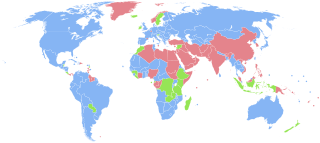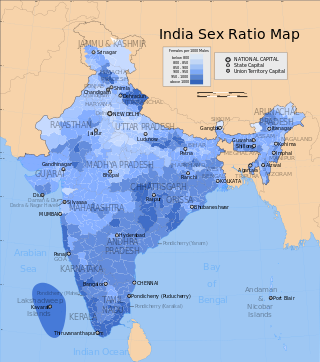List of states and union territories of India by sex ratio

Countries with more females than males Countries with more males than females Countries with very similar proportions of males and females (to 3 significant figures, i.e., 1.00 males to 1.00 females) No data |
Graphs are unavailable due to technical issues. There is more info on Phabricator and on MediaWiki.org. |
Sex ratio is used to describe the ratio of females to males in a population. In India, the sex ratio has been estimated via a number of methods and data sets including the decennial censuses, the National Family Health Surveys (NFHS), the Civil Registration System, the Sample Registration System and the Health Management Information System.[5] In 2014, the ratio of female births per 1000 male births varied from 887 to 918 using these estimates.[6] According to the NFHS-4 (2015–16) sex ratio of the total population (females per 1,000 males) was 991 (with an urban ratio of 956 and a rural ratio of 1,009).[4]
In 2011–2013, it was revealed through a population census with the Sample Registration System (SRS) that the sex ratio of India was 909 females per 1000 of males.[7] It has skewed downwards from then, recording 900 females in 2013–2015 and 896 in 2015–17 per 1000 of males.[7][8] Furthermore, that survey conducted with the SRS also showed Chhattisgarh as the highest sex ratio at 961, while Haryana was recorded the lowest at 831.[8]
The male-skew in India's sex ratio has increased since the early 20th century. In 1901 there were 3.2 million fewer women than men in India, but by the 2001 Census the disparity had increased by more than a factor of 10, to 35 million.[9] This increase has been variously attributed to female infanticide, selective abortions (aided by increasing access to prenatal sex discernment procedures), and female child neglect.[9] It has been suggested that the motivation for this selection against female children is due to the lower status and perceived usefulness of women in India's patriarchal society.
Ranking of states and union territories

In the table below, the rank numbers represented by 'S' are for states while 'UT' are for union territories. The data in the table is based on the population census of 2001 and 2011.
| No. | State/ Union Territory | NHFS-5 | 2011 Census | 2001 Census | Change (2001 to 2011) | ||||
|---|---|---|---|---|---|---|---|---|---|
| Rank (Sex ratio at birth) | Sex ratio at birth[10] | Sex ratio | Child sex ratio[11] | Sex ratio[12][a] | Child sex ratio[11] | Sex ratio[12] | Child sex ratio | ||
| 1 | Lakshadweep | UT1 | 1051 | 947 | 911 | 948 | 959 | ||
| 2 | Tripura | S1 | 1028 | 960 | 957 | 948 | 966 | ||
| 3 | Meghalaya | S2 | 989 | 989 | 970 | 972 | 973 | ||
| 4 | Uttarakhand | S3 | 984 | 963 | 890 | 962 | 908 | ||
| 5 | Arunachal Pradesh | S4 | 979 | 938 | 972 | 893 | 964 | ||
| 6 | Karnataka | S5 | 978 | 973 | 948 | 965 | 946 | ||
| 7 | Jammu and Kashmir[b] | UT2 | 976 | 889 | 862 | 892 | 941 | ||
| 8 | West Bengal | S6 | 973 | 950 | 956 | 934 | 960 | ||
| 9 | Mizoram | S7 | 969 | 976 | 970 | 935 | 964 | ||
| 10 | Sikkim | S8 | 969 | 890 | 957 | 875 | 963 | ||
| 11 | Manipur | S9 | 967 | 992 | 930 | 978 | 957 | ||
| 12 | Assam | S10 | 964 | 958 | 962 | 935 | 965 | ||
| 13 | Chhattisgarh | S11 | 960 | 991 | 969 | 989 | 975 | ||
| 14 | Puducherry | UT3 | 959 | 1037 | 967 | 1001 | 967 | ||
| 15 | Madhya Pradesh | S12 | 956 | 931 | 918 | 919 | 932 | ||
| 16 | Gujarat | S13 | 955 | 919 | 890 | 920 | 883 | ||
| 17 | Kerala | S14 | 951 | 1084 | 964 | 1058 | 960 | ||
| 18 | Nagaland | S15 | 945 | 931 | 943 | 900 | 964 | ||
| 19 | Uttar Pradesh | S16 | 941 | 912 | 902 | 898 | 916 | ||
| 20 | Andhra Pradesh | S17 | 934 | 993 | 939 | 978 | 961 | ||
| India | 929 | 943 | 919 | 933 | 927 | ||||
| 21 | Delhi | UT4 | 923 | 868 | 871 | 821 | 868 | ||
| 22 | Andaman and Nicobar Islands | UT5 | 914 | 876 | 968 | 846 | 957 | ||
| 23 | Maharashtra | S18 | 913 | 929 | 894 | 922 | 913 | ||
| 24 | Bihar | S19 | 908 | 918 | 935 | 919 | 942 | ||
| 25 | Punjab | S20 | 904 | 895 | 846 | 876 | 798 | ||
| 26 | Jharkhand | S21 | 899 | 948 | 948 | 941 | 965 | ||
| 27 | Telangana[c] | S22 | 894 | 988[13] | - | - | - | – | – |
| 28 | Odisha | S23 | 894 | 979 | 941 | 972 | 953 | ||
| 29 | Haryana | S24 | 893 | 879 | 834 | 861 | 819 | ||
| 30 | Rajasthan | S25 | 891 | 928 | 888 | 921 | 909 | ||
| 31 | Tamil Nadu | S26 | 878 | 996 | 943 | 987 | 942 | ||
| 32 | Himachal Pradesh | S27 | 875 | 972 | 909 | 968 | 896 | ||
| 33 | Goa | S28 | 838 | 973 | 942 | 961 | 938 | ||
| 34 | Chandigarh | UT6 | 838 | 818 | 880 | 777 | 845 | ||
| 35 | Dadra and Nagar Haveli[d] | UT7 | 817 | 774 | 926 | 812 | 979 | ||
| 36 | Daman and Diu | UT8 | 817 | 618 | 904 | 710 | 926 | ||
- Notes
- ^ "Child sex ratio" is the ratio of girls to boys in the age group of 0–6 years.
- ^ At the time of the census, Jammu and Kashmir was a state but from 31 October 2019, it has been split into two union territories, namely Jammu and Kashmir and Ladakh.
- ^ At the time of the census Telangana was a part of Andhra Pradesh. Telangana was declared as a separate state in 2014.
- ^ At the time of the census Dadra and Nagar Haveli and Daman and Diu were separate union territories. They became one union territories, Dadra and Nagar Haveli and Daman and Diu, in 2020.
See also
- Gender Development Index
- List of countries by sex ratio
- Child sex ratio
- List of countries by Social Progress Index
- International rankings of India
- Women in India
- Female infanticide in India
- Female foeticide in India
References
- ^ Data from the CIA World Factbook [1] Archived 12 August 2008 at the Wayback Machine. Map compiled in 2021, data from 2020.
- ^ "5: Gender Composition of the Population" (PDF), Provisional Population Totals – India, pp. 78–96
- ^ "1: Population" (PDF), Women and Men in India. Population related statistics., Ministry of Statistics and Programme Implementation
- ^ a b "National Family Health Survey (NFHS-4): India Fact Sheet" (PDF). rchiips.org. Ministry of Health and Family Welfare, Government of India. International Institute for Population Sciences, Mumbai. 2015–2016. Retrieved 10 September 2021.
{{cite web}}: CS1 maint: others (link) - ^ UNPFA, Sex Ratio at Birth in India (2020), 3.
- ^ UNPFA, Sex Ratio at Birth in India (2020), 5.
- ^ a b "Sex Ratio at Birth – India & Larger States". NITI Aayog. Archived from the original on 12 August 2021. Retrieved 8 September 2021.
- ^ a b Tripathi, Rahul (15 July 2019). "Survey shows sex ratio falling further to 896 in 3 years to 2017". The Economic Times. Retrieved 8 September 2021.
- ^ a b Bakshi, Roopa. "Declining sex-ratios – a matter of concern". UNICEF. Archived from the original on 14 September 2019. Retrieved 30 July 2018.
- ^ "Update on Child Sex Ratio". Press Information Bureau. Ministry of Health and Family Welfare, Government of India. 17 December 2021. Retrieved 16 January 2023.
{{cite web}}: CS1 maint: others (link) - ^ a b "Handbook of Statistics on Indian States 2020. Social and Demographic Indicators. Table 5: State-wise Sex Ratio". Reserve Bank of India. 13 October 2020. Retrieved 9 September 2021.
- ^ a b "Decline In Child Sex Ratio". Press Information Bureau. Ministry of Health and Family Welfare, Government of India. 11 February 2014. Retrieved 9 September 2021.
{{cite web}}: CS1 maint: others (link) - ^ "Statistical Year Book 2015" (PDF). telangana.gov.in. Directorate of Economics and Statistics, Government of Telangana. p. 3. Retrieved 10 September 2021.
The sex ratio is defined as the number of females per 1,000 males. This ratio for the state is 988 according to 2011 Census.
- Bibliography
- Kulkarni, Purushottam M. (2020), Sex Ratio at Birth in India: Recent Trends and Patterns (PDF), New Delhi, India: United Nations Population Fund,
(A report prepared for the United Nations Population Fund)
Further reading
- "Distribution of Population, Sex Ratio, Density And Decadal Growth Rate of Population (census-2011)". Election Commission of India. Retrieved 9 September 2021.(2011 figures)
- "Provisional Population Totals and Annexures" (PDF). Government of India (2011). Census of India. Archived from the original (PDF) on 12 January 2012.
- "Census of India 2001. Chapter 6: Sex Composition of the Population" (PDF). Census of India. Archived (PDF) from the original on 23 March 2021. Retrieved 8 September 2021.
- John, Mary E (16 April 2011). "Census 2011: Governing Populations and the Girl Child" (PDF). Economic & Political Weekly. XLVI (16) – via indiaenvironmentportal.org.in.
